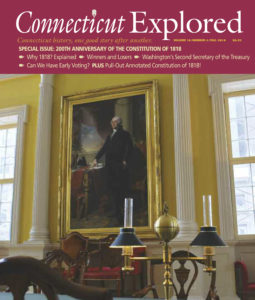(c) Connecticut Explored Inc. Fall 2018
SUBSCRIBE/BUY THE ISSUE
This special issue commemorating the 200th anniversary of the state’s adoption of a constitution includes a two-sided centerfold poster presenting the complete text of the constitution, annotated by members of the Connecticut Supreme Court Historical Society (CSCHS). Pull it out and refer to it as you read the stories in this issue. We’re providing it, along with the issue, to middle-school social studies and high-school civics classrooms across the state. The poster was supported by CSCHS and Connecticut Humanities, to whom we are grateful.
In this issue you’ll read about how the first state constitution advanced our state— and where it fell short. Connecticut was the next-to-last (thank you, Rhode Island!) of the original 13 colonies to adopt a state constitution—nearly 30 years after we became a state.
One place it fell short was in not enfranchising all citizens. We know well the long journey to women’s suffrage. But I’ve been wondering why, in the May 1814 legislative session, “free white male person” was added to the voter qualifications in a “further addition to” “An act for regulating the election of the Governor, Lieutenant Governor, and Assistants”—language that was again incorporated into the constitution itself.
Ramin Ganeshram, the new executive director of the Westport Historical Society, was interested, too. The historical society’s exhibition Rights for All?, on view through October 2018, includes some of the evidence dug up by researcher Christine Pittsley, whom I commissioned to look at an episode in Wallingford in 1803. The selectmen in that town were charged with fraudulently admitting unqualified men to the voting rolls—including two free African Americans named Toby Birdseye and Jack John (see page 38). These two men may be the two earliest examples of black suffrage in Connecticut—but we need more digging around in early town records to find out if there were other towns that admitted black men as voters before 1814.
But for me there’s one glaring omission in the Constitution of 1818: any mention of slavery. Slavery was legal in Connecticut until 1848. There had been attempts to end it sooner, including a gradual abolition act in 1784 (that passed) and an act to immediately abolish slavery in 1795 (that failed). By 1818 slavery had been all but abolished in the rest of New England, except Rhode Island. Vermont outlawed lifetime slavery in the constitution it adopted in 1777. Massachusetts effectively outlawed it in its constitution adopted in 1780. Its provision that “All men are born free and equal” led to successful challenges by several enslaved people asserting that it applied to them. No enslaved people were recorded in Massachusetts in the 1790 census, compared to Connecticut’s 2,648. New Hampshire’s constitution, adopted in 1783, used the same language as Massachusetts’s, but judicial interpretation there was more ambiguous. New Hampshire’s 1790 census counted 157 enslaved people; its 1810 census counted none. Even New York—with 15,000 enslaved people in 1810 to Connecticut’s 310—abolished slavery earlier than Connecticut. New York abolished slavery in 1817 (though the abolition became effective 10 years later). This can’t have gone unnoticed here. With slavery clearly on its way out in the North, why didn’t Connecticut follow its near neighbors and end it in our state constitution? When Rhode Island adopted a state constitution in 1843, it abolished slavery—still five years before Connecticut.
The period of the Constitution of 1818 is fascinating—a time of great change in the nation and in our own state. State Historian Walt Woodward’s expanded column this issue is a great place to start your exploration of the Constitution of 1818.
 Friends of Connecticut Explored
Friends of Connecticut Explored
Please support our work illuminating Connecticut’s history with a gift to the Friends of Connecticut Explored. Friends gifts support the magazine, creation of up-to-date educational materials for grades K-12, and our popular podcast, Grating the Nutmeg. Our Friends keep us publishing—we couldn’t do it without you!
Visit https://www.ctexplored.org/product-category/contributions/ or send a check to Connecticut Explored, PO Box 271561, West Hartford, CT 016271-561. Gift of $100 or more received by 12/31/18 will be listed in the Spring 2019 issue.
Elizabeth Normen is publisher of Connecticut Explored.
Explore!
Read all of the stories in the Fall 2018 issue
Read all of our stories about Governing the Colony & the State on our TOPICS page

